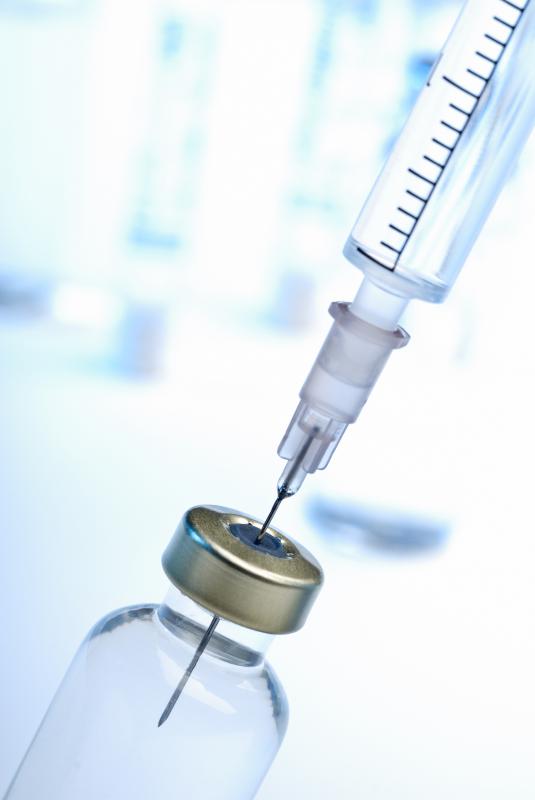At WiseGEEK, we're committed to delivering accurate, trustworthy information. Our expert-authored content is rigorously fact-checked and sourced from credible authorities. Discover how we uphold the highest standards in providing you with reliable knowledge.
How Do I Choose the Appropriate Syringe Size?
Although it is the most commonly used syringe type, the plastic piston-style syringe that first comes to mind is not the only type available. There are also epi-pen auto dispensing syringes and metal and glass cartridge syringe units. Thus, the choice of an appropriate syringe size depends upon the necessary syringe type, the intended use of the syringe, the amount of fluid to be withdrawn or the amount of medication to be administered, the size of available needles and the materials with which a syringe is manufactured.
Epi-pen and the metal and glass cartridge syringe units are manufactured in one size only. Only the medication dosage — self-contained in the epi-pen or prefilled in the glass canister and then placed in the metal syringe unit — differs. The choice of a syringe size only applies for the piston-style syringe.

The common plastic piston-style syringe is manufactured in a wide range of sizes, from 0.25 cc (or ml) to 450 cc, to allow for differences in use. Not only are syringes used with needles to administer medication, but syringes are also used to inflate bulbs to hold tubes within the body, to provide nutrition by nasogastric or stomach tube feedings, to withdraw fluid accumulations within the body and even to rinse, or irrigate, wounds or surgical incisions. The first decision in choosing an appropriate size is to know the purpose for which the syringe is intended. Most medications are administered using syringes of 10 cc size or smaller. This includes the tiny 0.25 cc tuberculin or insulin syringe used for intradermal (ID) or subcutaneous (SQ) injections, as well as 1 cc, 3 cc, 5 cc and 10 cc versions.

If the syringe will be used for administering medications, choose a syringe size sufficient to hold the prescribed dosage of liquid medication. This is of particular importance if the medication is to be administered through the skin with a needle, such as intramuscularly (IM), intradermally (ID) or subcutaneously (SQ). It is indicative of very poor nursing planning to administer two separate shots, or injections, to a patient in order to fulfill the prescription dosage requirements. When administering medication intravenously through either a large PICC or subclavian line or via a peripheral IV site, most authorities recommend using a 10 cc size syringe. This is suggested in order to avoid subjecting the vein to undue pressure and perhaps even causing the vein walls to burst.

As a general rule for non-IV medication administration, a smaller needle gauge should be used for a smaller syringe size. When syringes are being used for purposes other than medication administration, it is important to choose a syringe of sufficient size to hold the fluid anticipated to be withdrawn, or the amount of parenteral nutrition, for instance, to be administered. Often, research into the specific nursing procedure will provide the suggested syringe size as part of the lesson.
AS FEATURED ON:
AS FEATURED ON:
















Discussion Comments
This article seems to have missed an important point.
In general, the smallest-capacity syringe that will contain the required dose should be used. For example, if a 1 mL dose is required, a 1 mL or 3 mL syringe should be used. A 5 or 6 mL syringe probably wouldn't be too bad, but a 10 or 12 mL would be a poor choice. The primary reason for this is that it is easier to accurately measure the dose with the smaller syringe.
A 1 millimeter error in the position of the plunger corresponds to 16 times the error in volume for a syringe with a 2 cm inside-diameter barrel compared with a syringe with a 0.5 cm diameter barrel.
As noted in the article, an important exception is for cases where high pressure should be avoided.
Post your comments